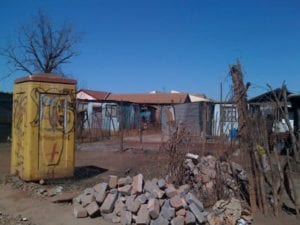On World Toilet Day, 2.5-billion people sit without access to adequate sanitation. A child dies every 15 seconds as a result.
In South Africa the move towards universal access has improved since 1994, but the census showed that 5.2% of households still do not have access. And a deeper reading into the statistics shows that a further 21% do not have access to an acceptable level of toilets. The Water Services Act states that, “everyone has a right of access to basic water supply and basic sanitation”. After several court cases and departmental pronouncements, this basic sanitation has been defined as to either be in the form of a flush toilet or a ventilated toilet. In its headline pronouncements about sanitation, government says that 13% of people do not have any access to any kind of toilet. And a further 2.1% are using the bucket system. This makes sanitation the one millenium development goal that the country is having a hard time meeting. Last year we saw the municipal election turn into the saga of open toilets. As a result the department of human settlements, which runs sanitation, asked a task team to tour the country and find out more about the situation. When he presented this report, Tokyo Sexwale, its minister, was adamant that sanitation would take centre stage in future infrastructure rollouts. “It’s a critical basic need, the first line of dignity of any human being that we take for granted as we open taps in our houses and as you flush toilets,” he said. The report found that the backlog sits at 2.5-million toilets. Census 2011 showed that progress has been made to giving universal sanitation. About 57% of households have access to a flush toilet that is connected to the sewage system; 3% to a toilet with a septic tank; 2.5% to a chemical toilet; and 8.8% to a pit toilet with ventilation. This is nearly 69% of the population, and the number stood at 58.6% when the last census was done in 2001. But 19% have access to a pit toilet without ventilation. In the statistics this is seen as having been served. But these toilets are a huge problem. The ventilation pipe at the back allows for air to circulate, this helps break down the sludge inside the toilet, stops flies from picking up and spreading disease, and importantly removes the smell. Without this, most nongovernmental organisations say that people do not use the toilets. A further 2.1% have to use the notorious bucket system, which government had promised to eradicate over a decade ago.When sanitation was still under water affairs, one of the taglines for the service was, “It should never be forgotten that ‘Sanitation is Dignity’ and dignity is a basic human right.”
The problem with these toilets, and flush toilets that block and also do not provide proper access, is evident throughout the country. And the statistics are constantly questioned. In the case of Khayelitsha, Cape Town, the number of people who have “access” to a toilet is relatively high. But access just means that people have a toilet that has been provided in their area. It does not take into account that the toilets can break or fill up or that one toilet can serve up to 50 people. Gavin Silber, coordinator of the Khayelitsha-based Social Justice Coalition, said in a recent visit that what is deemed to be access and the reality are very different. “On paper they say they have reached their targets and given an acceptable level of service. But you come here and you can see that many of these toilets just don’t work and you have dozens of people using one toilet. There is a big discrepancy,” he said. Jack Sim, founder of the World Toilet Organisation, which will be hosting the World Toilet Summit in Durban next month has said initiatives to tackle people’s lack of access to proper sanitation were not enough. “The reasons for such neglect are numerous. Part of it has to do with the fact that sanitation is considered a taboo subject; other reasons rest on demographic and population shifts; and others still rest on the fact that little investment has reached those who need it most due to mismanagement,” he said. A report published earlier this year for the Human Rights Commission, done after the open toilet saga by the department of performance monitoring and evaluation, found that service delivery was not fast enough. While 300 000 toilets were being delivered per annum, this rate would not achieve the target of universal access by 2014, it said. The report laid heavy blame on the fragmentation of sanitation services – it now formally resides in human settlements, but there are parts in water affairs and other parts in education and local government. “The challenge of institutional fragmentation needs to be addressed as a matter of urgency,” it said. And it recommended a single unit be established to oversee policy formulation, oversight and regulation. This should be based in water affairs, it said. It also said that it would take R44.5-billion to solve the crisis. http://mg.co.za/article/2012-11-19-access-to-adequate-toilets-hindered-by-blockages-in-the-system







